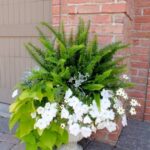Small gardens may present limitations in terms of space, but with the right designs and layouts, they offer endless possibilities for creating a beautiful and functional outdoor oasis. When it comes to garden designs and layouts for small gardens, it’s important to consider how to maximize the available space while still achieving a visually appealing and welcoming environment.
In this article, we will explore different techniques and strategies for making the most of small garden spaces, from utilizing vertical space to choosing the right plants and incorporating focal points.
Assessing your small garden space is the first step in understanding its limitations and opportunities. By taking stock of the available area, sunlight exposure, and existing features, you can begin to plan a design that makes the most of what you have.
Maximizing vertical space is a key aspect of designing for small gardens – walls and trellises can be utilized for planting, whether through climbing vines or hanging baskets. The right plant selection is also crucial; choosing varieties that thrive in small spaces can ensure that your garden remains lush and vibrant.
In addition to these considerations, creating focal points within the garden can add visual interest and draw the eye throughout the space. Utilizing container gardens is another effective way to make the most of limited ground space. By thinking strategically about paths and zones within your garden layout, you can optimize both functionality and aesthetics. With careful planning and thoughtful maintenance, even small gardens have the potential to become stunning outdoor retreats.
Assessing Your Space
When working with a small garden, it is important to carefully assess the space in order to maximize its potential. Here are some key considerations to keep in mind:
1. **Measure the Area:** Start by measuring the dimensions of your garden, including the length and width. This will give you a clear idea of how much space you have to work with.
2. **Sunlight and Shade:** Take note of where sunlight falls throughout the day and observe areas of shade. This will help you determine which plants will thrive in different areas of your garden.
3. **Soil Quality:** Assess the quality of your soil by performing a simple soil test. Understanding the PH levels and nutrient content of your soil will help you select plants that will grow successfully in your garden.
Once you have a clear understanding of the limitations and opportunities presented by your small garden space, you can then begin to plan and design accordingly. By making thoughtful choices about plant selection, layout, and maintenance, you can create a beautiful and functional garden that brings joy year-round.
Maximizing Vertical Space
Small gardens present a unique challenge when it comes to finding enough space for planting. However, utilizing vertical space by incorporating walls and trellises can significantly expand the planting area and create a visually appealing garden design.
Choosing the Right Support Structures
When maximizing vertical space in a small garden, it’s essential to choose the right support structures for your plants. Sturdy trellises, pergolas, and arbors can provide excellent support for climbing plants such as vines, cucumbers, and tomatoes. Additionally, wall-mounted planters or shelves can be used to display a variety of potted plants while adding an interesting visual element to the garden.
Creating Layers of Greenery
By training plants to grow vertically along walls and trellises, you can create layers of greenery that not only maximize space but also add depth and dimension to the garden design. Consider mixing different vine varieties with varying bloom times or foliage colors to create an eye-catching display throughout the growing season.
Vertical Gardens for Small Spaces
For extremely limited ground space, consider creating a vertical garden using modular wall planters or hanging pots. These systems allow you to grow herbs, flowers, or even small vegetables in a compact and efficient manner.
Vertical gardens are not only practical but also provide an innovative way to add visual interest to your small garden. Utilizing walls and trellises for planting is an essential technique for making the most of limited space while creating a lush and inviting outdoor oasis in even the tiniest of gardens.
Choosing the Right Plants
When selecting plants for a small garden, it’s also important to consider their growth habits. Opt for slow-growing or non-invasive species to prevent overcrowding and competition for resources. Additionally, choose plants that serve more than one purpose, such as those that provide both aesthetic appeal and practical use, like edible flowers or herbs.
To maximize the visual impact of your garden, consider incorporating a variety of plant shapes, sizes, and textures. This will add depth and diversity to your small space while preventing monotony. Combining different types of plants can create an interesting and dynamic garden despite its limited size.
| Plant Variety | Description |
|---|---|
| Dwarf Sunflowers | Compact version of traditional sunflowers with smaller stalks. |
| Roma Tomatoes | Bushy tomato plant ideal for container gardening. |
| Lavender Hidcote | Small-sized lavender variety perfect for borders or containers. |
Creating Focal Points
When designing a small garden, it is important to create focal points that will draw the eye and add interest to the space. Focal points can be anything from a striking plant or flower bed to a unique piece of garden art or sculpture. These features not only add visual appeal but also serve as anchor points, creating a sense of balance and harmony in the garden.
One popular focal point for small gardens is a water feature, such as a small fountain or birdbath. The sound of running water can create a soothing ambiance and can help mask any unwanted urban noise. Another option for creating a focal point is to use color strategically, such as planting a vividly colored flowering shrub or installing vibrant ceramic pots throughout the garden.
In addition to plants and decoration, using pathways and landscaping to lead the eye through the garden can also serve as focal points. Curved paths or plants arranged in a particular pattern can create visual interest and guide visitors through the space, allowing them to appreciate all the elements of the garden. By incorporating these focal points into your small garden design, you can transform even the tiniest outdoor space into a visually stunning oasis.
| Focal Point Ideas | Description |
|---|---|
| Water Features | A small fountain or birdbath that adds visual interest and creates relaxing sounds. |
| Strategic Color | Vividly colored plants or decorative pots strategically placed throughout the garden. |
| Pathways and Landscaping | Curved paths or unique landscaping arrangements that lead the eye through the space. |
Utilizing Container Gardens
When working with a small garden, maximizing limited ground space is crucial. One way to make the most of this space is by utilizing container gardens. Container gardens are a great option for small gardens because they allow you to grow plants in an organized and attractive way, without taking up precious ground space. By using containers, you can also move your plants around to optimize sunlight and aesthetic appeal.
When choosing containers for your small garden, consider both functionality and style. Look for containers that are large enough to accommodate the root systems of the plants you want to grow, but also match the overall design of your garden. Additionally, consider the material of the containers – while terracotta pots are classic and porous, they may dry out more quickly than plastic or metal options.
Another advantage of container gardening in a small space is the ability to grow a variety of plants, including flowers, herbs, vegetables, and even small trees or shrubs. The flexibility that containers provide allows you to create a diverse and visually appealing garden in a compact area.
This is especially beneficial if you have specific preferences or need to accommodate different light and soil conditions within your limited space. With proper care and maintenance, container gardens can thrive just as beautifully as traditional ground-planted gardens but with added versatility.
Designing Paths and Zones
When designing paths and zones in a small garden, it is essential to create a layout that optimizes both functionality and aesthetics. With limited space, every inch of the garden should be utilized wisely to ensure that it serves its purpose while still looking beautiful. Here are some tips for creating well-designed paths and zones in a small garden:
- Assess the flow: When designing paths, consider how people will move through the space. Ensure that there are clear and easy-to-follow pathways that lead visitors through different zones of the garden.
- Create distinct zones: Divide the garden into different areas such as seating, dining, a play area or a vegetable patch. Each zone should have its own purpose and feel distinct from the others.
- Utilize vertical space: To maximize ground space, consider using vertical elements such as trellises or hanging planters to create visual interest and add greenery without taking up valuable floor space.
By carefully planning the paths and zones in a small garden, you can create a functional and visually appealing outdoor space that feels open and inviting despite its size. Additionally, incorporating plants strategically throughout these areas can further enhance the overall aesthetic appeal of your small garden design.
Maintenance Tips
Keeping a small garden looking beautiful year-round requires consistent maintenance and care. With limited space, it’s important to stay on top of tasks to ensure that your garden continues to thrive. Here are some essential maintenance tips for keeping your small garden looking its best.
Regular Watering and Feeding
One of the most important aspects of maintaining a small garden is ensuring that your plants receive adequate water and nutrients. Be sure to water your plants regularly, especially during hot and dry periods. Consider using a drip irrigation system or soaker hoses to efficiently water your garden. Additionally, feed your plants with a balanced fertilizer to promote healthy growth and blooming.
Weeding and Pest Control
In a small garden, weeds can quickly take over and detract from the overall appearance of the space. Regularly inspect your garden for weeds and remove them promptly to prevent them from spreading. Additionally, keep an eye out for pests that may damage your plants. Consider using natural remedies or organic pest control methods to protect your garden without harming beneficial insects.
Pruning and Deadheading
Maintaining the shape and appearance of your plants is crucial for a tidy small garden. Prune shrubs and trees as needed to control their size and shape, and deadhead flowers to prolong their blooming period. This will not only keep your garden looking neat but also encourage new growth and flowering.
By following these maintenance tips, you can ensure that your small garden remains beautiful throughout the year. With proper care and attention, even the most compact outdoor spaces can be transformed into stunning havens of greenery and color.
Conclusion
In conclusion, small gardens have the potential to be just as beautiful and functional as larger ones. With careful planning and thoughtful design, it is possible to create a stunning outdoor space that maximizes every inch of available area. By making use of vertical space, choosing the right plants, creating focal points, incorporating container gardens, and designing efficient pathways and zones, small garden owners can create a space that is both visually appealing and practical.
It is important for those with small gardens to embrace the unique opportunities that come with limited space. Rather than seeing it as a constraint, it can be viewed as a chance to get creative and think outside the box.
There are countless ways to make the most of a small garden, from using walls and trellises for planting to carefully selecting plant varieties that thrive in confined areas. With the right approach, a small garden can become a tranquil retreat or a vibrant outdoor oasis.
In addition to design considerations, proper maintenance is essential for keeping a small garden looking beautiful year-round. Regular care, including pruning, watering, and general upkeep, will ensure that the garden remains an inviting and enjoyable space. With dedication and attention to detail, even the smallest of gardens can become a source of pride and joy for their owners.
Frequently Asked Questions
How Do You Structure a Small Garden?
When structuring a small garden, it’s important to consider the space available and what features you want to include. Start by creating defined areas for different purposes, such as seating or dining areas, pathways, and plant beds.
Consider incorporating vertical elements like trellises or hanging plants to maximize space. Don’t overcrowd the area with too many features – less is often more in a small garden.
How Do You Arrange Plants in a Small Garden?
Arranging plants in a small garden requires careful planning to make the most of the limited space. Choose a variety of plants with different heights, textures, and colors to add visual interest.
Group plants with similar care needs together to make maintenance easier. Consider using containers and raised beds to add depth and dimension to the garden while keeping everything organized.
How Do I Design a Small Garden Idea?
Designing a small garden idea involves considering both aesthetics and functionality. Start by thinking about how you want to use the space – whether it’s for entertaining, relaxation, or simply enjoying nature.
Then consider factors such as sunlight, soil type, and climate when choosing plants that will thrive in your specific conditions. Incorporate elements like paths, seating, water features, or art to enhance the overall design of the garden while making sure not to overwhelm the space with too much clutter.

Welcome to my gardening blog! I am passionate about plants and enjoy sharing my knowledge and experiences with others. In this blog, I will write about everything related to gardening, from tips on how to get started to updates on my own garden projects.





